Tools of the Trade: Whiteboard Wonders
By Sonja Yoerg | January 23, 2019 |
At bare minimum, all you need to write is either paper and ink, or a computer. Somehow that does not stop writers from coveting additional physical tools of the trade. Indeed, I’ve yet to meet a writer who doesn’t drool over office supplies. Can’t write without gel pens or stickies or a classic Moleskin? I thought so. Well, I’m here to lobby for my favorite writing accessory: the whiteboard.
Here are some ways I put my whiteboard to work:
Brainstorming. A blank sheet of paper or a blinking cursor on a white screen can be daunting, because it screams, Write something! But a whiteboard is not for writing per se, so its open expanse is more inviting than intimidating. Its simplest use is for spit-balling. Looking for a great title for your book? List the themes on the whiteboard and let your imagination run amok. Working on characters and relationships? Seeing the cast as an array, rather than a list, may help you make connections between them you hadn’t considered, or allow you to eliminate minor characters you really don’t need. I also use the whiteboard for creating character names and profiles. I can see how they look together, how they partition the space within the story to become memorable.
Here I am backpacking in Portugal, taking a moment to jot down some random thoughts.
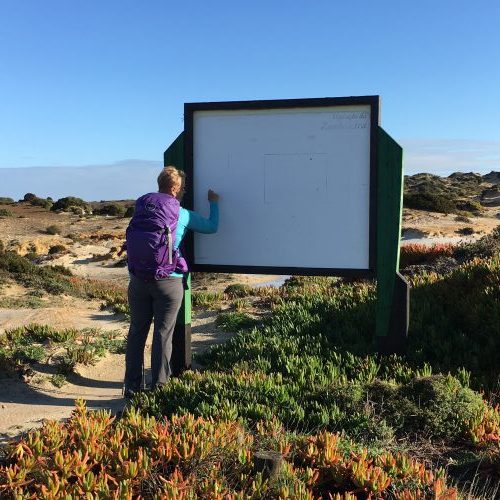
Sketching the Plot. Like most writers, I’ve employed all sorts of strategies to develop plot, including winging it. (Reformed pantser here!) I’ve dabbled in Save The Cat, Story Genius, and the like, but they only get me so far. As a visual person, I need to see the dimensions of the plot, to examine the scaffolding and judge whether it will bear weight over 350 pages.
Here’s an example from my WIP. Time runs horizontally, just like in math class. On the vertical I’ve listed the ways I’m making trouble for my main character. Using this format, I can see how the plot threads relate to each other and which characters are involved, so I can balance the events, keeping the rhythm strong and the narrative tight. I’d have trouble fitting this on a sheet of paper.
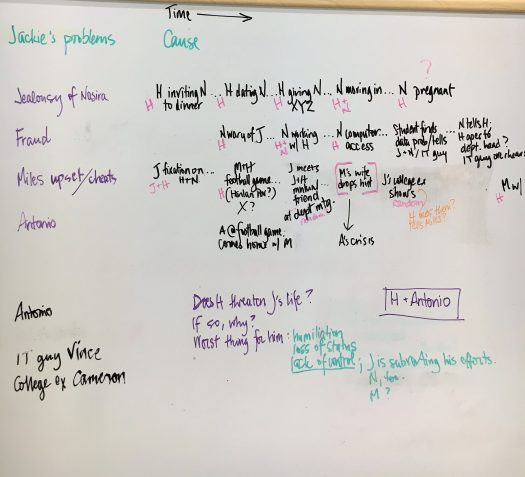
Pro-tip: Give your characters names starting with different first letters for extreme shorthanding. Readers will also appreciate the differentiation.
Developing Key Scenes. My favorite scenes to write have tons of characters in them. I love the way all the personalities and conflicts come alive when everyone is thrown together. Busy scenes cry out for scripting.
The opening scene of my WIP involves all four main characters. I barely know these people and I’ve invited them to eat together. Here I use my trusty whiteboard to map out the characters and their relationships, and to explore themes that might or might not be woven into the story.
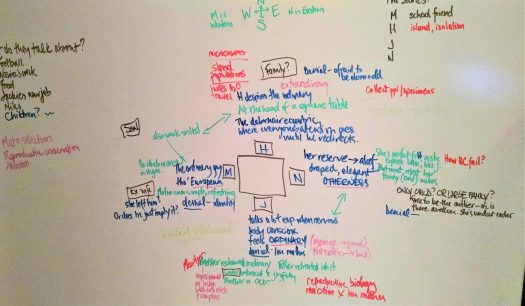
The same prescription can help with scripting complex plot points. Near the end of the story, plot threads must be braided together, and keeping track of it all makes my cortex ache. The whiteboard is my crutch, and my savior.
Creating Character Matrices. Writers focus heavily on character arcs, with good reason. We also attend to relationships between characters, and how they develop. While writing my third novel, I realized I could intertwine these concepts. Check out this grid.
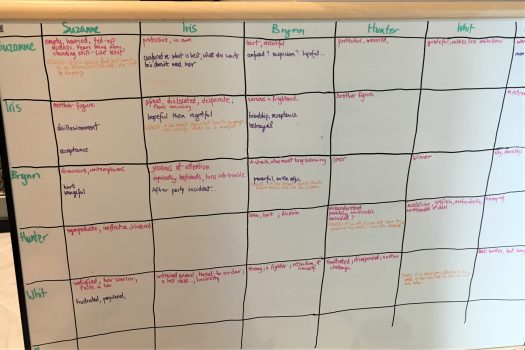
(This idea might not be original; please tell me if you’ve seen it elsewhere.)
TRUE PLACES, my new release, has five POVs. To track characters arcs and ensure balance, I wrote down how each character viewed each of the other characters at the beginning, middle, and end of the story. In a sense, I took the temperature of each paired relationship, from the two perspectives, as the story unfolded.
Pro-tip: Take photos of your whiteboard so you can use it again and again during a single project.
I stick by the truism that the only way a book gets written is by putting words on the page. Still, seeing your ideas in a different format can facilitate the process. The whiteboard is–for me and perhaps for you–a safe place to explore your work away from the page.
What physical tools do you use in your writing? Do any of them share features with my beloved whiteboard?

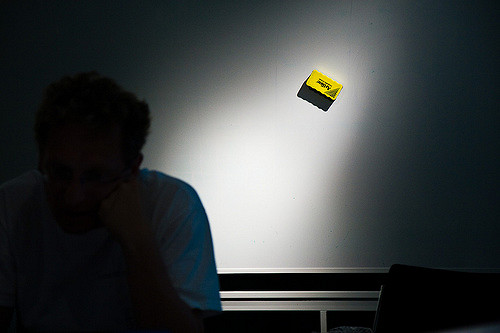








This is a great technique for visual writers. For one of my recent projects, I used a big sheet of poster board (because I had one languishing in my office closet) and a bunch of Post-It Notes (also had a ton of them laying around) and assigned a color for people (blue Post-Its), a color for places (yellow), and another color for plot points(pink). It was kind of messy, but I loved being able to move the Post-It Notes around at random or put related Post-Its on top of each other. Your point about writers loving office supplies is true!
A big sheet of poster board is a wonderful alternative to a whiteboard, Kathleen. Anything that helps you see your work in a new, and hopefully insightful, way is a valuable tool, and if you need to make an excursion for more office supplies, so much the better!
I am with you! Post-it notes on a large wall is my main tool. I took that idea from IT project planning years ago. You can use Post-it’s on a whiteboard to good effect, as well. I need visual aids for everything.
Hi Sonja!
I use my white board for brainstorming, or working out the rises & fall of tension (line graph), or character motivation lists.
Don’t use it every day, but it’s what frees me up, when I’m stuck!
Because I’m a total nerd, you had me at line graph, Laura. My notebooks are all graph paper…
Great ideas, Sonja. I’ll have to buy myself a white board!
My current WIP involves a road trip across the U.S. One of the first things I did was purchase a massive map of the United States. I’ve got each stop of the road trip marked on the map, with a clear line from start to finish. While I write, I follow my characters on the map.
I’ve also bought several non-fiction books regarding road trips across the U.S., including the best sights to see.
I live in Canada, but writing about my character’s experiences in another country makes me want to take the road trip myself. Summer 2019 might be fun–I’ve already got an itinerary mapped out!
Dee
Award-winning author of A Keeper’s Truth
Dee,
I love your road trip storyline! I’d write that book just to play with the maps. My second novel, Middle of Somewhere, takes place on the John Muir Trail in the High Sierra. My characters walked the length of it and I kept their hike true to the trail. So much fun, and now I want to do it again.
Enjoy your road trip!
I love my whiteboard! I often write novels with alternating time lines, past and present. I draw a huge arc on the whiteboard and put chapters in present above and chapters in past below…this way I can coordinate the story line into the same emotional and growth arc. It makes it easy to move a chapter forward or back as needed.
Great idea, Robin! And I hope you don’t mind if I steal it from you. I’ve got an old story with two timelines I’m going to revive, and your tip sounds perfect for it.
Hi Sonja, I’ve been jonesing for a whiteboard. Convinced. Like Kathleen, I’ve used the posterboard/Post-It method to evaluate narrative arcs and the overall flow of the narrative, but the whiteboard would work much better for brainstorming in my opinion. Thanks for exemplifying its best uses!
Bonus: you can bring it along to use as a visual aid when giving talks to writers at places that might not be outfitted for speakers, such as restaurants (had two such talks in the past two weeks).
Q: have you found one that erases well? One I borrowed from a friend carries the ghostly imprint of everything ever written on the board. I know all surfaces are not created equal, and I sense this is a case where cheaper is not better.
Try a Mr. Clean Eraser, Kathryn. Works amazingly well for stubborn whiteboard stains.
Smart idea about bringing a whiteboard along to use during a talk. Mine is a 3 x 4 ft and heavy, so not a good traveling companion. Maybe I need a smaller version…
Sonja, I started with recipe cards for plotting but have migrated to posterboard and Post-It notes for that purpose, using this method: https://www.cherryadair.com/Plotting_By_Color.html
But I also have a whiteboard and it’s my new BFF. Like you, its impermanence makes it feel friendlier, sillier, and that informality gets the creative juices flowing. (I use it to plotstorm and look for taglines and titles, mostly.) What ends up sticking ends up on paper, though, usually in Scrivener.
Love the character matrix idea! I’ve done something similar on paper regarding what each character knows at the start of each scene.
Hi Jan! I was thinking of writing a whole post about character matrices, then I realized I didn’t use that technique with the subsequent book. Why is it that I seem to want to reinvent the wheel every time I start a book? Sigh.
I’ve heard of but haven’t examined Adair’s technique. I’ll check it out!
I also love this idea. I wonder though, do you use more than one whiteboard? What happens when you’re done plotting and need another whiteboard for character interaction? Or, do you take a picture of it?
Yes, I take a photo of it, save it, and I’m ready for the next idea!
When I was writing a novel with past and present story lines, I used two different colors of Post-its and slapped them on the closet door. (Our whiteboard was way too small, and already in use!) Call it whiteboard improv.
Someone should write a book about all the ways writers use Post-its. The industry is keeping 3-M in business! Love the closet door idea, and it’s free!
I crouch on the floor and go mad on my flip-chart paper with coloured pencils … I like writing on paper better than on white boards (and I can handle pencils better than markers). Also I can put several of my diagrams next to each other. And when I am done, I can roll them up and pack them away. – But I guess the principle is the same. – I do character arcs, timelines, mind-map like objects that are incomprehensible for anyone but me. At the moment I am working on one I call “forces of conflict vs. forces of stability” (all targeting my poor hero, of course). Love it!
Love the character matrix idea!! Question I need to ask though…. what was that whiteboard doing in the Portuguese wilderness???